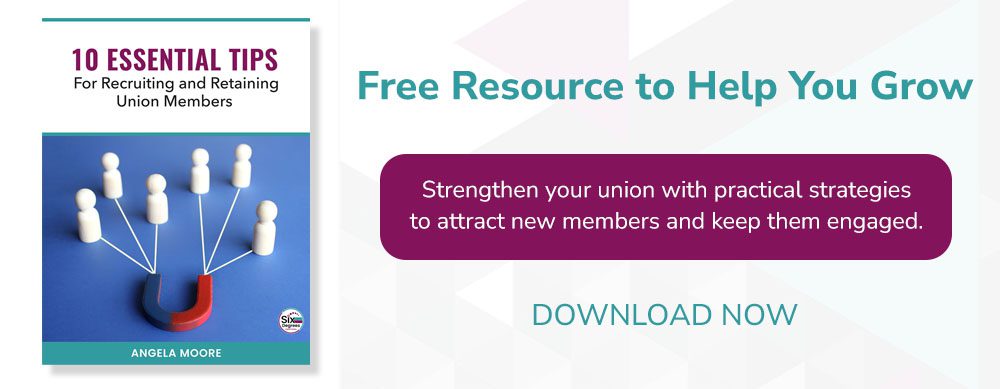Every union member has a story. Some have locked arms with their coworkers, standing in solidarity for fair wages and better working conditions. Others have leaned on their union when they needed support, whether it was fighting an unfair workplace policy, addressing safety concerns, or simply ensuring they were treated with the respect they deserve. And then there are those who haven’t needed direct representation but still know their union has their back.
These stories aren’t just compelling, they’re proof of what the union stands for. They show the real impact of union membership in ways that data and policy updates never could. Yet, many unions miss the opportunity to showcase these moments, leaving potential members unaware of just how much the union fights for them every day.
The good news? Sharing these stories doesn’t have to be complicated. Whether it’s a collective victory at the bargaining table, an individual who found justice through the grievance process, or a simple statement about why a member stays committed, every story matters. And for those who prefer anonymity, there’s still a way to highlight their experience while protecting their privacy.
In this guide, we’ll break down how to find, craft, and share powerful member stories that build trust, inspire engagement, and reinforce the strength of the union, because when members hear real stories from their peers, they see the union’s impact in action.
Why Success Stories Matter for Unions
A union’s strength isn’t just in contracts or negotiations, it’s in the real, everyday experiences of its members. Success stories aren’t just feel-good moments, they’re proof of the union’s impact. Whether it’s a major contract win, a grievance that protected a worker’s rights, or a member who simply found a sense of belonging, these stories show what the union stands for in a way that data alone never could.
For skeptical members, those who aren’t actively engaged, or even potential members who haven’t joined yet, hearing real experiences from their peers can be eye-opening. A well-told success story can shift perceptions, showing that the union isn’t just a distant organization, but an active force for fairness, respect, and workplace protections. For potential members, these stories highlight what the union is doing every day to support its members, which can foster a deeper sense of connection and community.
You’ve likely had that “wow” reaction yourself when hearing about a member’s story that made you proud to be part of the union. Maybe it was a case where a steward fought tirelessly to resolve a workplace issue, or a moment when workers stood in solidarity to win better wages. Those stories stick with us because they remind us why the union matters, not just as an organization, but as a collective of people looking out for one another.
Success stories don’t just build trust, they drive action. When members see their coworkers speaking up, standing together, and winning change, it inspires them to get involved. They realize that union advocacy isn’t just something that happens in negotiations, it’s something they can be part of.
For example, a member who received union support during a workplace dispute might share how it changed their entire perspective on what the union does. Or a group of workers who stood in solidarity for fair wages might tell how their collective action led to a better contract. These moments matter, and when shared, they remind both current and potential members why standing together makes all the difference.
How to Identify the Right Member Stories
Not all stories have the same impact. The most powerful ones highlight real transformation—where union support led to a meaningful difference in a member’s life.
What Makes a Strong Member Story?
- Clear Challenge: What issue did the member face? (e.g., unfair treatment, unsafe conditions, wage disputes)
- Union Action: How did the union step in? (e.g., steward advocacy, collective bargaining, legal support)
- Meaningful Resolution: What was the outcome? (e.g., policy change, improved workplace conditions, a member feeling heard and valued)
- Emotional Connection: Does the story inspire, educate, or motivate others to take action?
Diversity in Representation Matters
To resonate with all members, stories should showcase a variety of experiences:
- Different Job Roles & Industries – From healthcare workers to factory employees to educators, stories should reflect the union’s full membership.
- Various Challenges & Victories – Some members have won major policy changes, while others have had smaller but equally meaningful wins.
- Solidarity & Personal Impact – Highlight members standing together for better wages as well as individuals who benefited from union support in a workplace dispute.
Template: Questions to Ask for Member Stories
To gather the best stories, use these guiding questions:
- Tell us about a challenge you faced at work. What issue led you to seek union support?
- How did the union get involved? Who helped, what actions were taken, and how did it feel to have that support?
- What was the outcome? What changed in your workplace, and how did it impact you and your coworkers?
- Why does being a union member matter to you? How has this experience shaped your perspective on the union?
- What would you say to a coworker who isn’t involved in the union?
Best Ways to Collect and Share Member Stories
The best stories don’t just happen, they are uncovered. Gathering impactful member experiences requires a strategic approach and a plan for sharing them effectively.
How to Collect Member Stories
- Interviews & Testimonials – Sit down with members to ask open-ended questions about their experiences. A structured interview helps capture key details while keeping the story authentic.
- Survey & Story Submissions – Offer an easy way for members to submit their stories through an online form, email, or union meetings.
- Steward & Organizer Insights – Encourage stewards, labor relations teams, and organizers to share compelling stories they’ve encountered in the field.
- Member Spotlights – Regularly feature standout members in newsletters, meetings, or digital content to normalize storytelling as part of union culture.
Where & How to Share These Stories
- Video & Social Media – Short video testimonials or quotes with images resonate on platforms like Instagram, Facebook, and LinkedIn. A well-edited 60-second video can reach and engage more members than a long-form article.
- Newsletters & Internal Communications – A featured member story in a monthly newsletter reinforces union value and keeps success stories top of mind.
- Website & Member Portals – A dedicated section for real member experiences makes it easy for potential and existing members to see union impact firsthand.
- Live Meetings & Events – Stories shared in person, whether through panels, Q&A sessions, or member presentations, create a lasting emotional connection.
Example in Action
A short video clip featuring a member who successfully fought for improved benefits can serve multiple purposes. It can be shared on social media, embedded in an email campaign, and featured on the union website. By repurposing the content, the union maximizes reach and impact.
Common Mistakes & How to Avoid Them
Member stories are one of the most powerful tools for building trust and engagement, but if they aren’t told the right way, they can fall flat. Here are common mistakes unions make when sharing member success stories—and how to avoid them.
Too Much Focus on the Union
While the union plays a key role in securing wins, the story should center on the member’s experience. Instead of making it a promotional piece, focus on their journey—what they faced, how they took action, and how the union supported them. The more personal and relatable the story, the more impactful it will be.
Overcomplicating the Message
Avoid drowning the story in excessive details, legal jargon, or long-winded explanations. Instead, keep it clear, concise, and emotionally engaging. Focus on the challenge, the action taken, and the outcome. A compelling narrative should be easy to follow and resonate with members at every level of involvement.
Not Getting Consent
Before sharing any story, always get the member’s permission. Some may be open to using their name and photo, while others may prefer anonymity. In cases where privacy is a concern, consider presenting the story as a general case study, ensuring the details remain impactful while protecting identities. Union representatives or stewards can also share stories on behalf of members to maintain confidentiality.
Key Takeaway
A well-told, ethical, and member-focused story is far more effective than a generic success claim. Keep the member at the center, simplify the message, and always respect privacy when sharing their experience.
Moving Forward
Member success stories are more than just feel-good moments—they are powerful tools for building trust, engagement, and union solidarity. When members see real examples of how the union has made a difference, they feel more connected, informed, and empowered to take action.
Even a handful of well-crafted stories can shift perceptions, encourage participation, and reinforce the value of being part of the union. The key is to collect and share stories in a way that is authentic, accessible, and aligned with your members’ experiences.
Want to build stronger member connections? Let’s create a strategy that helps your union showcase the power of its people.






